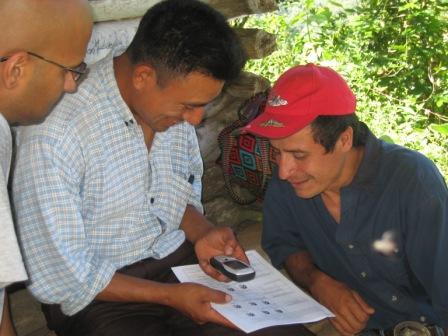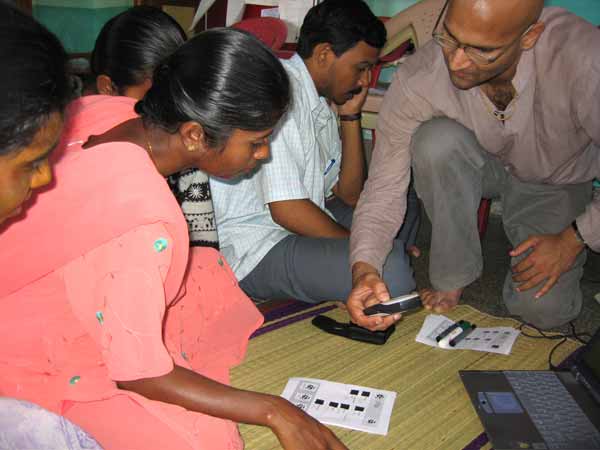Contribute
| Tapan Parikh – Technology Review’s Humanitarian Of The Year 2007 |
Raj Melville
08/07/2008
I had the pleasure of meeting Tapan Parikh a few weeks ago when he presented on a panel at a conference. The panel focused on the latest trends in technology with the rest of the panelists discussing emerging areas in nanotechnology, biomedicine and energy. Tapan provided a refreshingly different viewpoint that emphasized the needs of the end user in developing countries. By harnessing technology to make things simpler, Tapan has provided platforms that make the daily grind of field workers in rural parts of the world a lot easier.
Even before Microfinance became popular when Prof. Yunus was awarded the Nobel Peace Prize, Tapan was interested in how it was structured, particularly in rural India. As a young doctoral student, he ventured out to India to better understand the nuances of how small self managed groups functioned in collecting, managing and lending their money. Out of this early work with the Media Lab India, he helped fashion Hisaab a simple software program with an easy interface that villagers could use to maintain accounts.
Tapan was born in Queens, New York and grew up around New York City. After an undergraduate at Brown in molecular modeling, he ventured west to complete his Masters and Doctorate in Computer Science at the University of Washington. Throughout his academic career he did several stints in India at Gujarat Vidyapith, SRISTI, Media Labs Asia and Microsoft Research India maintaining his connection with his roots.
He has applied his research skills in human-computer interaction to come up several innovative ideas that address socio-economic issues. He has also setup a company in India, ekgaon Technologies, to help develop information systems and technologies for developing communities.
One of his innovations is the CAM platform for data acquisition in the field. Realizing that the cell phone was the most ubiquitous technology platform around the world, Tapan and his colleagues devised a system that used camera-enabled cell phones and preprinted, bar-coded forms to allow field workers to easily input data, forms and pictures. The field worker used a cell phone camera to capture 2D barcodes on the forms. The user was then prompted to enter data on the phone through a series of prompts corresponding to the specific form. The application stored data on a storage card if the phone was out of coverage and could later upload the data to a central server.
The CAM platform has several interesting uses in developing countries. Working with microfinance organizations in India, the CAM platform has been tailored to help with collecting data from the numerous self help groups. By reducing errors in data entry and the time required in inputting data, the application helps improve efficiency and accuracy for microfinance field operations. The mobile phone platform provides a cost effective computing platform that can be easily deployed in remote rural areas.
As ecologically and socially conscious customers increase demand for organically grown and fair trade goods, small farmers in developing countries have an opportunity to differentiate themselves by supplying these goods. The process to get certified as an organic or other ‘green’ labeled producer is a tedious and labor intensive one. Inspectors from certifying agencies visit the farms to verify compliance. Thereafter the farmer has to travel to the local collection point to have their produce weighed and recorded before they get paid. Using the CAM platform, the inspection and certification process has been streamlined. An inspector can now take a photo of the farmer’s environment on the camera phone to document actual growing conditions. When the farmer brings his produce in to be weighed, a camera phone captures barcoded data from a form and generates the appropriate data entry prompts on the phone. The data is transmitted to the central server for further processing.
Tapan continues to work with projects around the world from India to Africa and Latin America. For his innovative and inspiring work, Tapan was identified as one of the 35 Innovators under age 35 by MIT’s Technology Review magazine and named Technology Review’s Humanitarian of the Year for 2007. He continues to teach and research interesting new ideas for the bottom of the pyramid at the University of California, Berkeley.
For more information on some of the organizations in this article:
Tapan Parikh’s Home Page: http://people.ischool.berkeley.edu/~parikh/
Ekgaon technologies: http://www.ekgaon.com/home
Hisaab: http://hisaab.sourceforge.net/
You can contact me with ideas, suggestions or for more information at: SELokvani@gmail.com
You can continue this dialog on my blog at: http://socialecosystem.wordpress.com/
You may also access this article through our web-site http://www.lokvani.com/


(Photo courtesy of Tapan Parikh)
(Photo courtesy of Tapan Parikh)

(Photo courtesy of Tapan Parikh)